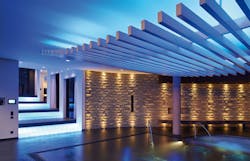Design firm Tobias Link created LED lighting installations in a Zurich luxury residence, including auto-themed lighting in a garage and a soothing nature experience in the spa area.
By Maury Wright, Editor, LEDs Magazine and Illumination in Focus
We most often discuss LED lighting relative to energy savings, but solid-state lighting (SSL) technology enables projects that couldn’t be realized practically with legacy sources. Consider the Zurich, Switzerland private residence that graces our cover. The Tobias Link design firm utilized color-tunable LED-based products to enable an ambience and a theme matched to the uses of both a garage/entertainment space and a pool/spa area. In this instance, controls are used to programmatically deliver the intended experience as opposed to boosting energy efficiency, although the use of LED lighting makes such a project feasible in terms of energy usage.
The two areas of the residence use very similar lighting technologies, but the installations deliver dramatically different experiences. The garage area delivers an energetic vibe while the spa area is meant to soothe in all of the program choices.
The garage area was designed both to accommodate the homeowner’s automobiles and to serve sporadically as an exhibition space and to host events. Tobias Link delivered an auto-themed design in which ceiling light patterns resemble roadways or even a racetrack. The designer said that the system even directs autos into the appropriate places similar to the way taxiways direct airport traffic.
Color-tunable LED-based lighting enables an auto-themed design in which ceiling patterns resemble roadways or racetracks in the garage, which is not only used to house the homeowners’ vehicles but also to entertain guests. (Images courtesy of photographer Tom Gundelwein)
The RGB (red, green, blue) enabled fixtures were installed on the low ceiling and in coves and deliver uniform yet dynamic lighting across the ceiling. The delivered intent was to make the ceiling appear “paper thin,” according to the designers.
While the theme was meant to provide a Formula One vibe, the design actually mixes past and futuristic elements. Tobias Link installed some historic luminaires to create synergy with some of the vintage autos in the homeowner’s collection of sports cars.
Wellness area
In the wellness area, the challenge was creating a nature-centric theme with a variety of programs that deliver specific scenarios, all of which are meant to invoke a soothing atmosphere. The wellness area includes shower rooms, changing rooms, and massage rooms. The open pool area includes a sauna/steam bath, a scented fountain, and an adventure shower that delivers a mix of water features, programmable scents, and programmed sound tracks.
The indoor area looks out upon the Alps and that setting provided the impetus for the nature theme. The primary component of the design concept is the wave-shaped sculpture located above the pool that was constructed with wood beams. RGB lighting installed on top of the beams delivers the dynamic light show indirectly with the ceiling as the canvas.
The wellness area invokes a nature-inspired spa experience by using programmable RGB lighting that delivers light shows based on lava stream, ocean current, flower meadow, and white light themes. (Images courtesy of photographer Tom Gundelwein)
The designers programmed the system to deliver four themes: heat of the lava stream, cool ocean current, fresh flowery meadow, and white light. The concept supports a cooler theme for a hot summer day or a warmer theme for a cold March/April night. The design also uses unobtrusive vertical white light in niches that was carefully installed not to infringe on the dynamic lighting while providing functional ambient illumination.
The Zurich project uses LEDLUX Linear LX fixtures from Insta Elektro GmbH. The linear fixtures can be configured into continuous runs ranging from about 3m to 23m. Insta also offers flexible versions of the fixtures in lengths to 5m and that capability was key for the garage design.
Tobias Link implemented the control system as well as combining a range of technologies and products. The system uses the European Installation Bus to connect all the various components. The DMX protocol carries the control data. And equipment and software from Traxon’s E:Cue business unit (an Osram company) was used to control the lighting system.









